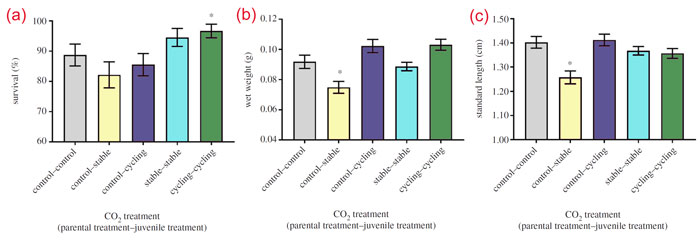| Tweet | Follow @co2science |
Paper Reviewed
Jarrold, M.D., and Munday, P.L. 2019. Diel CO2 cycles and parental effects have similar benefits to growth of a coral reef fish under ocean acidification. Biology Letters 15: 20180724, http://dx.doi.org/10.1098/rsbl.2018.0724.
One of the structural problems inherent with almost all laboratory-based ocean acidification studies is that they utilize static pCO2 seawater values. For example, a marine organism under examination will typically be subjected to a fixed (non-oscillating) control or elevated pCO2 seawater value, despite the fact that its natural habitat experiences substantial fluctuations in pCO2 over a variety of temporal scales.
However, the importance of including pCO2 cycles in ocean acidification (OA) studies is becoming increasingly recognized, as negative (or perceived to be negative) results obtained in static OA experiments have been overturned or reversed when seawater pCO2 fluctuations are included on daily, weekly or even longer seasonal scales (see, for example, Comeau et al., 2014; Jarrold et al., 2017]). Consequently the results obtained from static or stable pCO2 experiments are of less ecological relevance than OA experiments conducted under fluctuating seawater pCO2.
The latest research study to confirm this fact comes from Jarrold and Munday (2019), who examined the growth and survival of juvenile cinnamon anemone fish (Amphiprion melanopus) reared in one of three pCO2 treatments: (1) a control treatment where pCO2 was kept constant at 500 µatm, (2) a stable elevated treatment where pCO2 was kept constant at 1000 µatm, or (3) a fluctuating elevated treatment with a mean daily pCO2 value of 1000 µatm that oscillated ±300 µatm about the mean in a 24 hour period.
Jarrold and Munday's experiment began by collecting adult breeding pairs of anemone fish from the Great Barrier Reef, which were then acclimated in one of the three pCO2 treatments three months prior to the breeding season. Following egg hatching, juveniles from parents in the control treatment were divided and reared among all three of the pCO2 treatments, whereas juveniles from parents in the stable elevated and fluctuating elevated treatments were kept in their respective pCO2 environments. Altogether, this led to five separate treatments (1) control-control, where parents and juveniles were both exposed to a constant 500 µatm pCO2 seawater environment, (2) control-stable, where juveniles from parents in the constant 500 µatm treatment were reared in a constant 1000 µatm pCO2 environment, (3) control-cycling, where juveniles from parents in the constant 500 µatm treatment were reared in a fluctuating 1000 ± 300 µatm pCO2 environment, (4) stable-stable, where parents and juveniles were both exposed to a constant 1000 µatm pCO2 seawater environment and (5) cycling-cycling, where parents and juveniles were both exposed to a fluctuating 1000 ± 300 µatm pCO2 seawater environment. After 28 days the authors ended the experiment and evaluated juvenile survival, wet weight and standard length.
The results are illustrated in the figure below. As indicated there, juvenile survivorship was highest (96.7%) in the cycling-cycling treatment and lowest (82.2%) in the control-stable treatment. Thus, compared to the control-control treatment (which had a survival percent of 88.7%), the treatment that is closest to what occurs in the natural environment (i.e., the cycling-cycling treatment, where both parents and offspring experience fluctuating pCO2 values) produced a result that is opposite that observed in the treatment most commonly utilized in OA studies (i.e., the control-stable treatment, where the species is subjected to non-fluctuating elevated pCO2 seawater). In other words, the treatment conditions more akin to real nature (cycling-cycling) saw survivor rates increase (relative to the control-control treatment), whereas the treatment conditions utilized in most OA studies (control-stable) experienced a relative decrease in juvenile survival. Thus, a more realistic scenario completely changed the future outlook for the survival of this species from negative to positive!
With respect to the other two growth-related parameters examined in the study, Jarrold and Munday write that "juvenile exposure to stable elevated CO2 (control-stable) caused an 18.5% and 10.7% reduction in wet weight and standard length, respectively, compared to the control-control treatment." However, they note that "there were no significant differences between the control-control and other treatment groups, indicating that both diel CO2 cycles and parental exposure to elevated CO2 restored growth to the same level as control."
In light of all the above, the two researchers conclude that "parental exposure to stable elevated CO2 and within-generation exposure to diel-cycling elevated CO2 both alleviate the negative effect of elevated CO2 on juvenile growth of [Amphiprion melanopus]." And they say that their study "adds to a growing body of literature that highlights the importance of incorporating natural CO2 variability in OA experiments to accurately predict the responses of shallow water coastal marine species to rising CO2 levels." We couldn't agree more. Hopefully, policy makers will take note and withhold or suspend judgment on this issue until there is enough research conducted properly to provide a realistic assessment of the future effects of OA on marine life.

Figure 1. Effects of within-generation and parental exposure to ocean acidification on the (a) survival, (b) wet weight and (c) standard length of juvenile cinnamon anemone fish. Bars represent means ± standard error. Asterisks (*) denote a significant difference compared to the control-control treatment. CO2 treatment differences are described in the text above. Source: Jarrold and Munday (2019).




